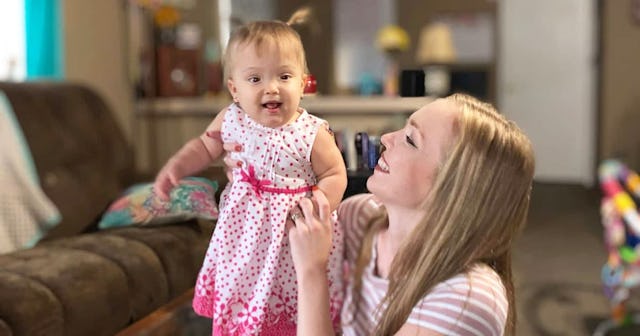Baby Who Had Fetal Surgery For Spina Bifida Was Born Wiggling Her Toes

The medical advancements of today’s world are nothing short of a miracle. Even just ten years ago, the prognosis of spina bifida — a congenital birth defect which causes a baby’s spinal cord to fail at developing or close properly in the womb — seemed like a fearful life sentence full of tubes, catheters and paralysis for so many families. But now, a new fetal surgery that helps with spina bifida is beginning to strip away these expectations and provide a new lease on life.
One such family who has reaped the benefits of the operation? Erika Reyes and her easy-going toddler Ava.
Courtesy of Erika Reyes
After five years of trying to get pregnant, a visit with two IVF specialists, one miscarriage and two ectopic pregnancies, 27-year-old Florida mother Reyes and her husband found themselves elated when they conceived baby Ava without medical intervention. But at what was meant to be a normal 24-week anatomy scan, Reyes lived what she calls an “out of body experience” upon hearing the news that her sweet girl was one among the 1,645 babies in the U.S. annually diagnosed with spina bifida.
“When you hear spina bifida, you don’t really know what that is. But they explain it to you and tell you, ‘Her spinal cord is detached, it didn’t grow properly,’ and when you think of spinal cord, you think of walking,” Reyes tells Scary Mommy. “And then we were told she may never walk.”
Courtesy of Erika Reyes
Among the risk of paralysis, babies with spina bifida may have trouble with their bladder and bowels, breathing, eating, and talking, and can require around-the-clock care for the entirety of their life. While there is no cure for the defect, new-age fetal procedures are offering a new type of hope that spina bifida surgery after birth does not bring.
“The surgery is risky, but research shows that babies who are closed in-utero have better neurologic outcomes than babies treated after birth,” Stephen Emery, M.D., director of Center for Innovative Fetal Intervention at UPMC Magee-Women’s Hospital tells Medical Xpress.
Because the surgery is so risky, not only for baby but also mom, fetal surgery for spina bifida is rare. So rare that there had only been one other surgery like it in the state of Florida when Reyes and her husband were given their daughter’s diagnosis.
“I didn’t know what to think. I was just thinking, ‘What is her quality of life going to be? What’s her life expectancy? Is it going to affect how many years she has on this earth?'” Reyes says. “‘Is she going to be brain dead? Is she going to be in a hospital bed, hooked up to ventilators and breathing machines her whole life?'”
Courtesy of Erika Reyes
After Ava’s diagnosis, Reyes and her husband were initially urged to either allow surgeons to perform surgery on Ava after she was born or to terminate the pregnancy. Although the option to terminate was pushed on the family a few times, being a likely procedure that plays out with spina bifida diagnoses, Ava went with her nurse’s added suggestion and moved forward with the process of applying for fetal surgery to correct her daughter’s spina bifida.
Following a series of extensive medical testing and evaluations, both Ava and Reyes were accepted for the surgery and went under anesthesia at 26 weeks gestation at Orlando Health for fetal surgery.
“They performed a C-section on me to get to Ava,” Reyes says. “[The surgeon] went in my belly and grabbed Ava, flipped her over to her back, and she was actually missing skin on her back so they actually had to put a skin graft in when they were repairing her spine. And then they just sewed me back up, and she was still in my belly.”
Courtesy of Erika Reyes
Four weeks later, Ava was born at 30 weeks and 2 days wiggling her toes with full feeling from her waist down. As Reyes says, her daughter is “twice born.” And after 87 days in the NICU, it was finally time for this little family of three to head home.
“It was my nephew’s birthday party the next day, so the only person who knew we were coming home was my husband’s sister. And she helped me surprise everyone at the birthday party,” Reyes said. “There were so many tears going around. It was amazing.”
While Reyes was pregnant, she was informed that fetal surgery for her daughter’s spina bifida would give her a 50% chance of mobility. Now, Ava is a happy 15-month-old toddler with full feeling and reflexes, and her achievements because of the operation are nothing short of a medical miracle.
Courtesy of Erika Reyes
This, Reyes says, is the very reason she advocates for spina bifida and spreads awareness about the fetal surgery.
“If I would have listened to everything they were telling me, and went forward with [termination], I wouldn’t have her,” she says. “I get to see her progress so much. I get to see her fall and get back up. She’s teaching me so much more than I’m teaching her.”
Courtesy of Erika Reyes
Before she’s even hit her preschool years, Ava has been pictured on billboards across the country for spina bifida awareness, inspiring millions to change the way we perceive the condition affecting thousands of Americans today. And as for Reyes…well, she’s just helping Ava along the way while loving “everything about being her mom.”
This article was originally published on